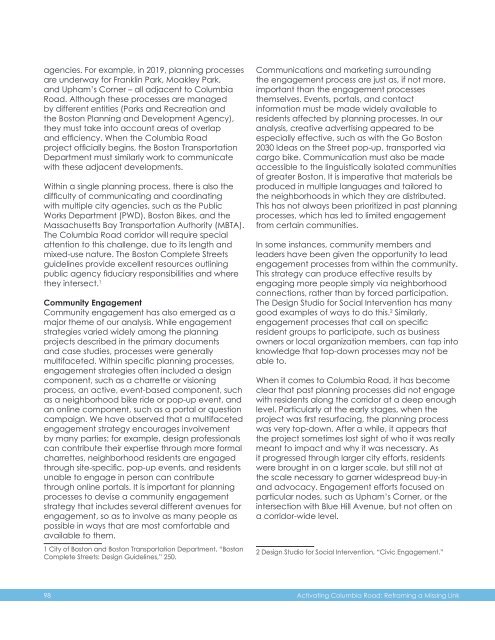Activating Columbia Road: Reframing a Missing Link
This report was guided by Field Projects, an Urban Planning practicum at Tufts University. Our team (Aqsa Butt, Xianzheng Fang, Marah Holland, Lev McCarthy, and Megan Morrow) was partnered with LivableStreets Alliance to consolidate previous studies, recommendations, and outreach methods relating to Columbia Road. This was in effort to inform Livable Streets’ future community engagement along the corridor.
This report was guided by Field Projects, an Urban Planning practicum at Tufts University. Our team (Aqsa Butt, Xianzheng Fang, Marah Holland, Lev McCarthy, and Megan Morrow) was partnered with LivableStreets Alliance to consolidate previous studies, recommendations, and outreach methods relating to Columbia Road. This was in effort to inform Livable Streets’ future community engagement along the corridor.
Create successful ePaper yourself
Turn your PDF publications into a flip-book with our unique Google optimized e-Paper software.
agencies. For example, in 2019, planning processes<br />
are underway for Franklin Park, Moakley Park,<br />
and Upham’s Corner – all adjacent to <strong>Columbia</strong><br />
<strong>Road</strong>. Although these processes are managed<br />
by different entities (Parks and Recreation and<br />
the Boston Planning and Development Agency),<br />
they must take into account areas of overlap<br />
and efficiency. When the <strong>Columbia</strong> <strong>Road</strong><br />
project officially begins, the Boston Transportation<br />
Department must similarly work to communicate<br />
with these adjacent developments.<br />
Within a single planning process, there is also the<br />
difficulty of communicating and coordinating<br />
with multiple city agencies, such as the Public<br />
Works Department (PWD), Boston Bikes, and the<br />
Massachusetts Bay Transportation Authority (MBTA).<br />
The <strong>Columbia</strong> <strong>Road</strong> corridor will require special<br />
attention to this challenge, due to its length and<br />
mixed-use nature. The Boston Complete Streets<br />
guidelines provide excellent resources outlining<br />
public agency fiduciary responsibilities and where<br />
they intersect. 1<br />
Community Engagement<br />
Community engagement has also emerged as a<br />
major theme of our analysis. While engagement<br />
strategies varied widely among the planning<br />
projects described in the primary documents<br />
and case studies, processes were generally<br />
multifaceted. Within specific planning processes,<br />
engagement strategies often included a design<br />
component, such as a charrette or visioning<br />
process, an active, event-based component, such<br />
as a neighborhood bike ride or pop-up event, and<br />
an online component, such as a portal or question<br />
campaign. We have observed that a multifaceted<br />
engagement strategy encourages involvement<br />
by many parties; for example, design professionals<br />
can contribute their expertise through more formal<br />
charrettes, neighborhood residents are engaged<br />
through site-specific, pop-up events, and residents<br />
unable to engage in person can contribute<br />
through online portals. It is important for planning<br />
processes to devise a community engagement<br />
strategy that includes several different avenues for<br />
engagement, so as to involve as many people as<br />
possible in ways that are most comfortable and<br />
available to them.<br />
1 City of Boston and Boston Transportation Department, “Boston<br />
Complete Streets: Design Guidelines,” 250.<br />
Communications and marketing surrounding<br />
the engagement process are just as, if not more,<br />
important than the engagement processes<br />
themselves. Events, portals, and contact<br />
information must be made widely available to<br />
residents affected by planning processes. In our<br />
analysis, creative advertising appeared to be<br />
especially effective, such as with the Go Boston<br />
2030 Ideas on the Street pop-up, transported via<br />
cargo bike. Communication must also be made<br />
accessible to the linguistically isolated communities<br />
of greater Boston. It is imperative that materials be<br />
produced in multiple languages and tailored to<br />
the neighborhoods in which they are distributed.<br />
This has not always been prioritized in past planning<br />
processes, which has led to limited engagement<br />
from certain communities.<br />
In some instances, community members and<br />
leaders have been given the opportunity to lead<br />
engagement processes from within the community.<br />
This strategy can produce effective results by<br />
engaging more people simply via neighborhood<br />
connections, rather than by forced participation.<br />
The Design Studio for Social Intervention has many<br />
good examples of ways to do this. 2 Similarly,<br />
engagement processes that call on specific<br />
resident groups to participate, such as business<br />
owners or local organization members, can tap into<br />
knowledge that top-down processes may not be<br />
able to.<br />
When it comes to <strong>Columbia</strong> <strong>Road</strong>, it has become<br />
clear that past planning processes did not engage<br />
with residents along the corridor at a deep enough<br />
level. Particularly at the early stages, when the<br />
project was first resurfacing, the planning process<br />
was very top-down. After a while, it appears that<br />
the project sometimes lost sight of who it was really<br />
meant to impact and why it was necessary. As<br />
it progressed through larger city efforts, residents<br />
were brought in on a larger scale, but still not at<br />
the scale necessary to garner widespread buy-in<br />
and advocacy. Engagement efforts focused on<br />
particular nodes, such as Upham’s Corner, or the<br />
intersection with Blue Hill Avenue, but not often on<br />
a corridor-wide level.<br />
2 Design Studio for Social Intervention, “Civic Engagement.”<br />
98 <strong>Activating</strong> <strong>Columbia</strong> <strong>Road</strong>: <strong>Reframing</strong> a <strong>Missing</strong> <strong>Link</strong>



